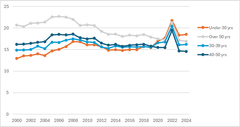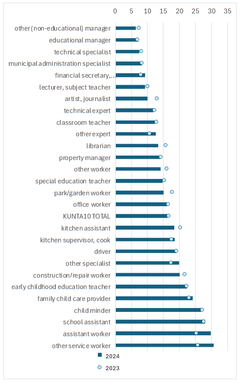Fewer sickness absence in the municipal sector than ever since 2000
In 2024, municipal employees were on average 16.3 days absent from work due to their own illness. The figure is almost at the same level as in 2023 when we saw a clear turn for the better after the growth peak caused by COVID-19. The amount of sickness absence is now lower than ever during the 25-year follow-up.
Finnish Institute of Occupational Health media release 11 June 2025
The Kunta10 study of the Finnish Institute of Occupational Health has followed employees' sickness absence in 11 cities since 2000. In 2022, the coronavirus pandemic caused a spike in sickness absence, but the growth remained temporary. In the years following the coronavirus pandemic and the national reform on healthcare and social welfare, sickness absence days have decreased and stabilised to a lower level.
"After the national reform on healthcare and social welfare, the average sickness absence rate in the municipal sector has fallen to a lower level than ever before since 2000,” says Jenni Ervasti, Chief Researcher at the Finnish Institute of Occupational Health.
Since 2023, municipal employees, apart from Helsinki, have no longer included personnel from health care, social welfare and rescue services, which has a partial impact on the figures.
Sickness absence rate among young people continues to be high
Sickness absence among municipal employees under the age of 30 continue to show a worrying development. Although the peak during the coronavirus pandemic levelled off, level of sickness absence among young people is clearly higher than in older age groups ( see Figure 1).
On average, young people have 5.5 more sickness absence days per person-year than in the corresponding age group in the early 2000s.
It seems that the age group over 50 has seen the most positive development. People who are currently over fifty years of age are less often absent from work due to their own illness than people of the same age were in the early years of the follow-up.
There are clear socio-economic health disparities between occupational groups
The mean number of sickness absence days varies clearly between occupational groups. The mean for management and expert positions was seven days per person-year in 2023 and 2024, while in physical and manual tasks, the mean number of sickness absence days increased to up to 30.
The highest rate of sickness absence was recorded by assisting employees and other service employees who work in construction, maintenance, kitchens and public transport customer service, among other sectors (see Figure 2).
Sickness absence among schoolteachers was lower than among other educational professionals: on average 9 days for secondary school/high school teachers and 12 days for primary school teachers. Early childhood education teachers, childcare providers and family day care providers accumulated more than 20 days of absence.
"This is at least partly attributable to the fact that those working with children below school age have a higher than average risk of infectious diseases,” Ervasti estimates.
One in five municipal employees were not on sick leave for a single day in 2024
In 2024, one-fifth (21%) of the employees of the municipalities participating to the study was not once absent from work due to their own illness. Over the longer term, the proportion of people with zero days of illness has been declining, except for an increase likely to be due to coronavirus restrictions in 2020–2021.
"In the early stages of the pandemic, social interaction was restricted, which also reduced the spread of other infectious diseases. In addition, remote work could also make it possible to work with partial work ability," Ervasti says.
In 2023 and 2024, the situation returned to the pre-pandemic level.
When viewed by occupational group, the proportion of people with zero days of illness is usually inversely proportional to the average number of days of sickness absence. The proportion of people with zero days of illness in management and expert positions was high, 33–46%.
"The possibility of remote work or lighter work can reduce the need to record an absence day if the employee feels that they are partially able to work,” Jenni Ervasti says.
Kunta10 study
- Sickness absences in municipalities 2000–2024 data and analysis related to the latest data in the Work-Life Knowledge service:
https://tyoelamatieto.fi/en/home/data/sickness-absence-in-finnish-municipalities/ - The Finnish Institute of Occupational Health’s Kunta10 study is Finland’s largest follow-up study of municipal employees. The study involves Helsinki, Espoo, Vantaa, Tampere, Turku, Oulu, Naantali, Raisio, Nokia, Valkeakoski and Virrat.
- The annual sickness absences of more than 90,000 municipal employees is monitored from the personnel registers of employers in a uniform manner in proportion to the actual sickness absence days and the number of person-years worked. The follow-up has been continued since 2000.
- The statistics of the Kunta10 study cover all absences due to the employees’ own illness from the first day of absence, but do not include information on the reasons for sickness absences.
- The sickness absence statistics for 2024 are based on 71,990 person-years.
Further information
Jenni Ervasti, Chief Researcher, Finnish Institute of Occupational Health, jenni.ervasti@ttl.fi, +358 43 825 5475
Keywords
Contacts
Juha Hietanensenior specialistTyöterveyslaitos | Finnish Institute of Occupational Health | Arbetshälsoinstitutet
Tel:+358504773267juha.hietanen@ttl.fiPäivi Lehtomurtocommunications managerTyöterveyslaitos | Finnish Institute of Occupational Health | Arbetshälsoinstitutet
Tel:+358504156309paivi.lehtomurto@ttl.fiImages


Links
WELL-BEING THROUGH WORK
The Finnish Institute of Occupational Health (FIOH) researches, develops and specializes in well-being at work. It promotes occupational health and safety and the well-being of workers. It is an independent institution under public law, working under the administrative sector of the Ministry of Social Affairs and Health. It has five regional offices, and its headquarters are in Helsinki. The number of personnel is about 500.
For the media | Finnish Institute of Occupational Health (ttl.fi)

Alternative languages
Subscribe to releases from Työterveyslaitos
Subscribe to all the latest releases from Työterveyslaitos by registering your e-mail address below. You can unsubscribe at any time.
Latest releases from Työterveyslaitos
Työterveyslaitoksen tutkimuskatsaus: joulukuu 202517.12.2025 08:32:40 EET | Tiedote
Tässä tutkimuskatsauksessa on esitelty tiiviisti kahdeksan tuoreinta tutkimusta Työterveyslaitoksen tutkijoilta. Niissä on tarkasteltu esimerkiksi kaupan alan työkuormitusta, osasairauspäivärahan käyttöä ja sitä, millainen lyhytpsykoterapian ja muun keskusteluhoidon nykytila on työterveyshuolloissa. Tutkimuskatsauksen avulla pääset nopeasti ajan tasalle tuoreista tutkimusjulkaisuista.
Ekologisk hållbarhet är en konkurrensfördel för företag – digitalisering påskyndar den gröna omställningen12.12.2025 06:00:00 EET | Pressmeddelande
Verksamhetens ekologiska hållbarhet har särskilt i stora företag blivit en betydande konkurrensfaktor. I enkäten Digivihreä siirtymä ja työ (Digital och grön omställning och arbete) utredde man hur den gröna omställningen syns i företagens strategi, vardagliga verksamhet och innovationer.
Ekologinen kestävyys on yritysten kilpailuetu – digitalisaatio vauhdittaa vihreitä innovaatioita12.12.2025 06:00:00 EET | Tiedote
Toiminnan ekologinen kestävyys on erityisesti suurissa yrityksissä noussut merkittäväksi kilpailutekijäksi. Digivihreä siirtymä ja työ -kyselyssä selvitettiin, miten vihreä siirtymä näkyy yritysten strategiassa, arjen toiminnassa ja innovaatioissa.
Ecological sustainability is a competitive advantage for companies – digitalization is accelerating the green transition12.12.2025 06:00:00 EET | Press release
Ecological sustainability has become a significant competitive factor, especially for large companies. A survey on the twin (digital and green) transition and work investigated the ways in which the green transition is reflected in companies’ strategy, daily operations and innovations.
Undersökning: Inom handelsbranschen bör man vara uppmärksam på belastningstoppar4.12.2025 06:00:00 EET | Pressmeddelande
Arbetets belastning inom handelsbranschen är rimlig, men det förekommer belastningstoppar i arbetet. För fysisk belastning finns det redan hjälpmedel. Stöd behövs emellertid även för psykisk belastning, såsom svåra möten med kunder. Dessutom kräver det stora antalet unga arbetstagare och den höga omsättningen inom handelsbranschen god och kontinuerlig introduktion.
In our pressroom you can read all our latest releases, find our press contacts, images, documents and other relevant information about us.
Visit our pressroom